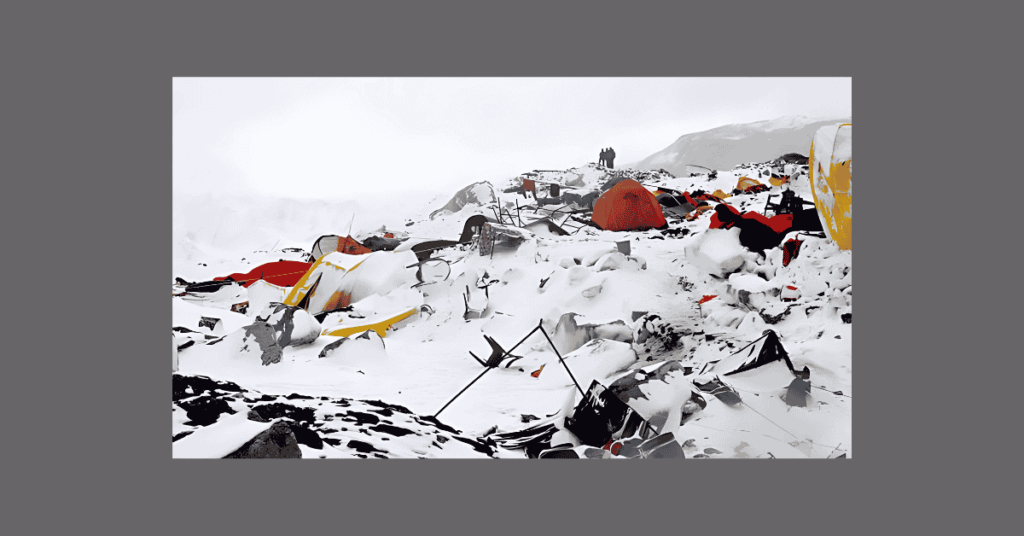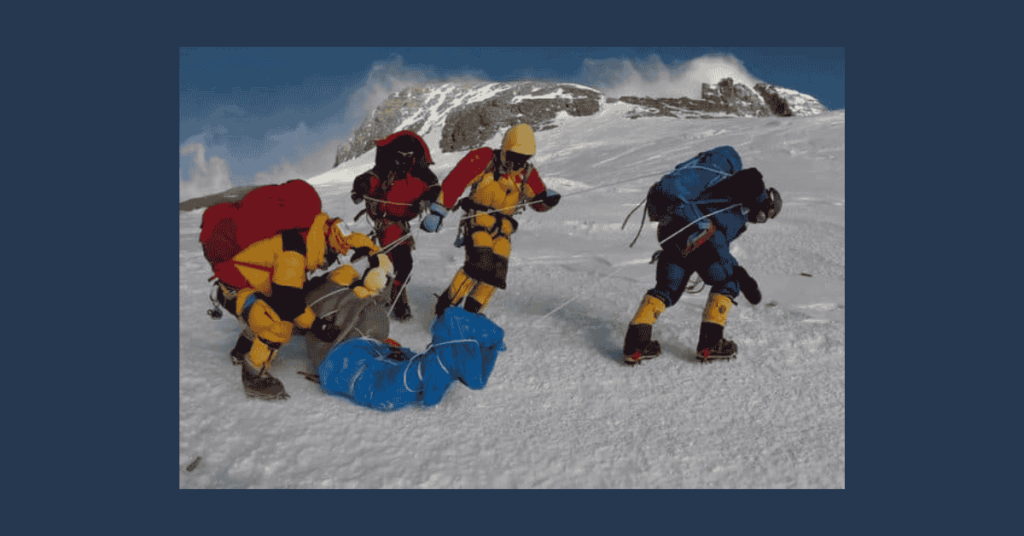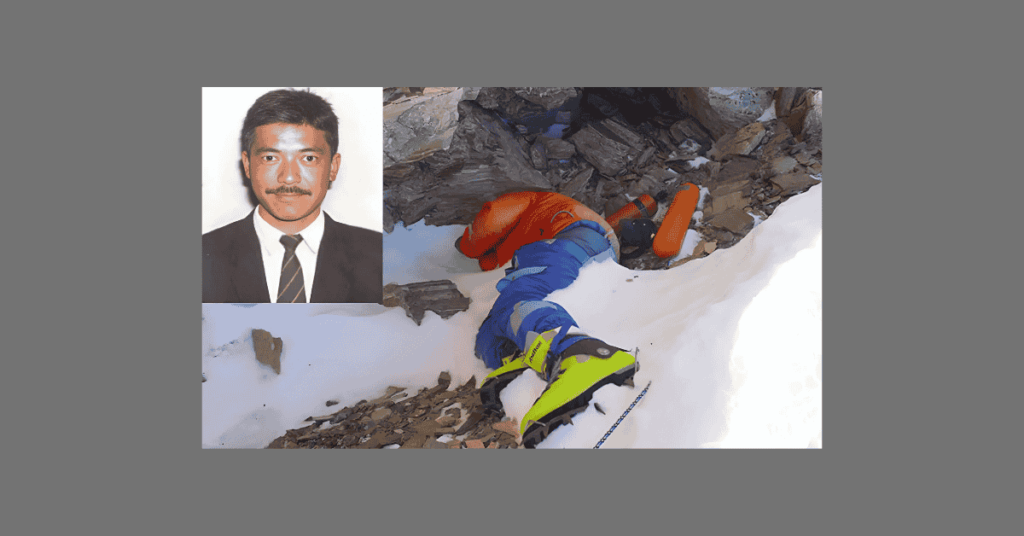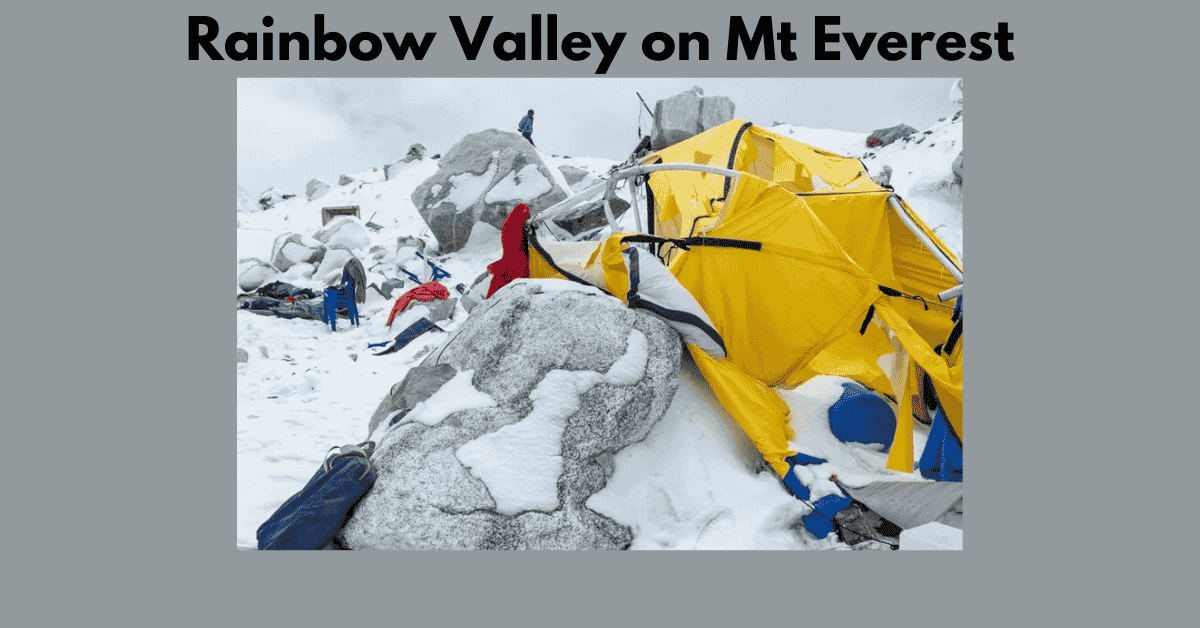Color and Tragedy: The Story of Rainbow Valley on Mt. Everest
The Rainbow Valley of Mount Everest, Nepal, may sound like a beautiful destination, but its name carries a tragic story. Located near Camp IV in the notorious Death Zone, this area is marked by the vibrant, multicolored gear and clothing of climbers who lost their lives while attempting to conquer the mountain. The extreme altitude, harsh weather, and limited oxygen turn this region into a perilous path, where bodies often remain untouched due to the impossibility of safe recovery. Over time, the accumulation of brightly colored jackets and equipment against the icy slopes created a haunting yet vivid spectacle—thus giving birth to the name Rainbow Valley.
What is Rainbow Valley in Everest?

Despite its beautiful name, the Rainbow Valley holds a chilling truth. Found along the Northeast Ridge Route of Mount Everest, this area has become a graveyard for climbers who perished during their expeditions. But why is it called Rainbow Valley? The answer lies in the sight of the lifeless bodies, dressed in brightly colored jackets and gear, scattered across the snow. These vibrant hues form a grim reminder of lost lives, creating a stark contrast against the icy terrain. The name is more symbolic than literal, as it doesn’t resemble a typical “valley” but rather a somber section of the mountain.
Where is Rainbow Valley in Everest
Rainbow Valley, situated at around 8,500 meters below the summit on Everest’s northern side, is a chilling and unavoidable landmark. Climbers using this route have no choice but to step around the lifeless bodies of those who either failed to reach the peak or fell to their deaths on the descent to Camp IV. This area is considered an ultimate graveyard, filled with the tragic stories of climbers like Yasuko Namba and Neal Beidleman, who were deemed too weak to be rescued and left behind to face the harsh fate of the mountain. The reality is far more haunting than depicted in movies like “Everest,” where such chilling decisions are often softened or rewritten for dramatic effect.
Read More: korina harrison
Why the dead bodies are everywhere in Rainbow Valley
When climbers perish high up on Everest, their bodies often remain frozen in place for years, preserved by the mountain’s brutal conditions. Before starting their expedition, climbers must sign agreements either to pay a hefty fee (over $70,000) for body recovery or to be left on the peak. Most accidents and fatalities occur in the Death Zone, typically after summiting, and many of these bodies eventually end up in Rainbow Valley—a chilling “graveyard” of colorful remains. The narrow trail through this area is so tight that climbers have to push past any fallen bodies, forcing them to slide down the slope, where they ultimately rest in this eerie landmark.
Do they remove bodies from Everest

Why don’t they remove the bodies and return them to their families? It’s not as simple as it sounds. Recovering bodies at such extreme altitudes is nearly impossible due to Everest’s harsh conditions and treacherous terrain. Helicopters can’t reach these heights because of fierce winds and thin air, leaving only human power as an option. But who would risk their life to recover the dead? Very few. That’s why most bodies are left behind, turning the slopes into a colorful graveyard known as Rainbow Valley. While a few families have managed to retrieve their loved ones for over $70,000, this isn’t feasible for everyone, and even with the funds, success is never guaranteed.
Where is the death zone on Mt Everest
The Death Zone on Mount Everest, sitting at elevations above 8,000 meters (26,247 feet), is notorious for its deadly reputation. Over 200 climbers have perished in this treacherous area out of the 295 recorded deaths since 1924. It’s named the Death Zone for a reason: the human body simply cannot adapt to the drastically reduced oxygen levels here. With only one-third of the oxygen available compared to sea level, running out of supplemental oxygen means a slow, suffocating death. Climbers have little time to linger, and the narrow trail leaves no room for error—making this section one of the most dangerous on the entire mountain.
What is the chance of dying on Mount Everest
Since 1924, nearly 5,000 climbers have reached the summit of Mount Everest, with 295 recorded fatalities, resulting in a death rate of just under 1%. This statistic marks a significant improvement from the 2.2% death rate seen between the 1970s and 1980s, as advancements in gear and climbing techniques have enhanced safety measures over the years. According to a report by the BBC, the leading cause of death on Everest is avalanches, accounting for approximately 41.6% of fatalities, while mountain sickness is responsible for around 22.2%. These statistics highlight the ongoing dangers climbers face, even as overall death rates decline.
Where is green boots on Everest
One of the most infamous figures in Everest lore is “Green Boots,” a nickname for the corpse of Indian climber Tsewang Paljor, recognizable by his distinctive bright green mountaineering boots. At an elevation of 27,890 feet (8,500 meters), his body is found in a cave, surrounded by empty oxygen cylinders. Paljor was part of a six-member Indian team, and according to team leader Harbhajan Singh in a BBC interview, he and his friend Smanla reached the summit, making them the first Indians to successfully ascend Mount Everest from the north side. Tragically, on their descent to Camp IV, they were caught in severe weather. Now, the haunting image of Green Boots remains forever embedded in the mountain’s history, a somber reminder of the risks faced by climbers in their quest for the summit.
What happened to Green Boots body?

Tsewang Paljor’s body, which went missing in 2014, was presumed either buried in the snow or removed. However, in 2017, it reemerged, still resting in the same location. Today, his remains serve as a grim landmark for climbers attempting to conquer Everest from the north face, acting as an eerie trail marker that highlights the dangers of this formidable mountain. His presence continues to remind adventurers of the risks involved in their quest to reach the highest point on Earth.
FAQs
What is Rainbow Valley on Mount Everest?
Rainbow Valley is a grim section of Mount Everest located near Camp IV, known for the brightly colored gear of climbers who have died there. The area has become a haunting graveyard, with lifeless bodies preserved by the mountain’s extreme conditions, creating a stark contrast against the icy landscape.
Why are there so many bodies in Rainbow Valley?
Climbers who perish in the Death Zone often remain on the mountain due to the dangerous conditions that make recovery nearly impossible. Before expeditions, climbers must sign agreements regarding body recovery, and many choose to leave their loved ones behind rather than face the risks of retrieval.
What is the Death Zone on Mount Everest?
The Death Zone refers to elevations above 8,000 meters (26,247 feet) on Mount Everest, where the oxygen levels are insufficient for human survival. This area is notorious for its high fatality rate, with many climbers succumbing to altitude sickness, exhaustion, or accidents.
What happened to the bodies of climbers like Green Boots?
Green Boots, the nickname for Tsewang Paljor, is one of the most well-known bodies on Everest. His remains were discovered in a cave at high altitude, serving as a cautionary landmark for climbers. While some bodies have been recovered, many, like Green Boots, remain on the mountain due to the risks involved.
What are the main causes of death on Mount Everest?
The leading causes of death on Everest include avalanches, which account for around 41.6% of fatalities, followed by mountain sickness, responsible for approximately 22.2%. While the overall death rate has declined over the years, the dangers of climbing remain significant.
In Shot
As climbers continue to challenge the formidable heights of Everest, the stories etched into the icy slopes of Rainbow Valley underscore the delicate balance between ambition and survival in the world’s highest peaks.
Stay Connected: Tribuneradar.com






